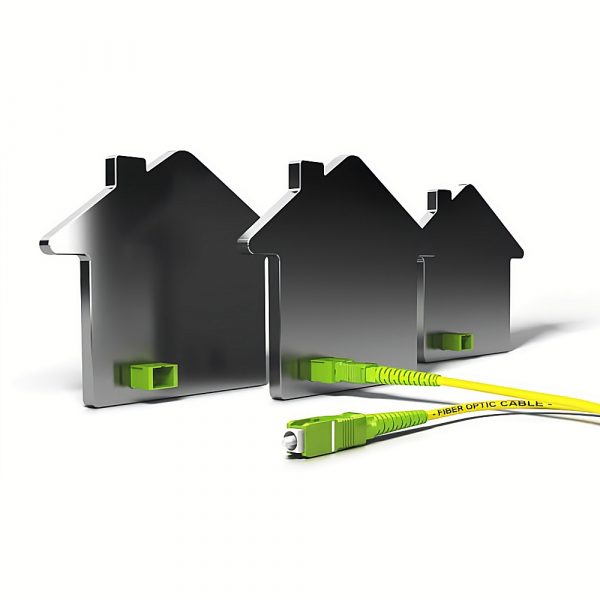New UK Home Building Rules Set to Mandate Gigabit Broadband

After a long wait, the UK Government has today finally tabled a consultation on changes to the existing Building Regulations (2010), which will effectively make it mandatory for property developers to ensure that almost every new home is built with support for “gigabit” speed broadband ISP connections.
At present around 93% of new build homes are already being created with support for Fibre-to-the-Premises (FTTP), which is up sharply from a little over 60% back in 2017 (here). Meanwhile, around 65% of all premises across the UK can today access a gigabit-capable broadband network, which tends to reflect coverage from both FTTP and DOCSIS 3.1 based Hybrid Fibre Coax (HFC / Cable) lines.
We should point out that network operators, such as Virgin Media (VMO2), Gigaclear, Openreach (BT), Hyperoptic and many more, have already made it cheaper and easier for developers to deploy FTTP. The Government have, until now, also been taking a soft approach by encouraging councils to ensure that they factor at least “superfast broadband” (30Mbps+) into local planning approvals for new build sites
Advertisement
Despite this, some property developers still claim that deploying such broadband services can become prohibitively expensive, particularly in remote rural areas, due to the lack of any gigabit-capable networks nearby. Not that this has prevented many of those same companies from raking in big annual profits.
However, this is a gap that the Government are keen to plug, particularly in light of their new £5bn Project Gigabit programme, which itself aims to help extend “gigabit-capable” network coverage to at least 85% of UK premises by the end of 2025, before reaching universal coverage by around 2030. This scheme targets its help toward the final 20% of predominantly rural premises.
The New Building Regulations
The solution to all this, says the government, is to introduce new secondary legislation by amending the existing Building Regulations (2010), which means that developers will be “legally required to install high-quality digital infrastructure from the outset, make it a priority as part of the build, and ensure broadband companies are on board before the first brick is laid,” said DCMS last year (here).
Below is a summary of the key changes that were announced as part of the original proposal in 2020.
Advertisement
The Key Changes
➛ Developers must ensure new homes have gigabit broadband. This includes ensuring that the physical infrastructure necessary for gigabit-capable connections is provided on site for all new build developments and that the home is connected by an operator to a gigabit-capable connection (consisting of infrastructure including ducts, chambers and termination points – up to the network distribution point where reasonably practicable).
➛ The requirement on the developer to provide a gigabit-capable connection exists unless the cost to the developer of providing connectivity exceeds £2,000 (cost cap that includes VAT), or the operator declines to provide a connection.
➛ If gigabit broadband exceeds the cost cap, the developer must provide “the next fastest broadband connection” (at least 30Mbps+ is expected, but it could be as slow as the USO speed of 10Mbps+) within the same cost cap.
➛ The policy will apply to all new residential dwellings, including self-built homes, but excluding renovated buildings. The Government are also “consulting on the applicability of the requirements to buildings converted to homes.”
➛ To make sure developers are incentivised to follow the plans, the government has worked with operators to secure “significant new commitments”(i.e. they will contribute to the costs of installing gigabit broadband in new-build homes). We’ve updated the following list to include the most recent commitments from operators.
— Virgin Media will contribute at least £500 and, in the case of some larger sites, £1,000.
— Openreach has committed to a combined contribution with developers of £3,400 (same as the broadband USO level), with a maximum developer contribution of £2,000.
— Gigaclear will offer to provide connectivity to such new build properties at a contribution of up to £1000 per property.
— VXFIBRE has separately said they can contribute £500 and up to £2,000, depending on the specific situation.
Building regulations are a devolved matter, thus any amendments mentioned here will only apply in England. However, the government has said that they intend to “work closely with the Devolved Administrations” (i.e. Scotland, Wales and Northern Ireland) to help them implement this, consistently, across the UK.
Sadly, progress has been extremely slow since the changes were first unveiled back in March 2020, which was largely due to delays related to the COVID-19 pandemic. The good news is that the Government has today taken a long awaited step forward.
In order to amend Building Regulations, the Government are required by the Building Act 1984 to conduct a technical consultation. The purpose of today’s new consultation, which is open to the public (until 28th February 2022), is thus to seek views on the proposed new gigabit-capable broadband legal requirements and the associated statutory guidance for developers in relation to new build homes.
The Government said they would “aim to publish the consultation response and lay the implementing legislation as soon as Parliamentary time allows, with the legislative amendments coming into force as soon as possible,” which is sadly quite vague. But hopefully we won’t have to wait quite as long for an update as last time.
Advertisement
Admittedly, the new rules don’t cover everything and, in fairness, that’s to be expected. For example, we suspect that some self-built homes will probably slip through the cracks, as the cost of connecting them to gigabit lines in remote rural areas would simply not be viable until better underlying infrastructure becomes available. In the meantime, the caveat to allow 10Mbps+ connections may enable self-builds to continue without facing extreme costs.
DCMS Statement
Where a developer is unable to secure a gigabit-capable connection not exceeding the cost cap, a developer will be required to install the next best technology connections available, provided this can be done without that connection also exceeding the cost cap.
In the first instance this should be at least a superfast 30 Mbps connection and failing that at least a standard [10Mbps+] broadband connection, as defined in the Broadband Universal Service Obligation. Where no connection can be secured without exceeding the cost cap, the first requirement to install the physical infrastructure necessary for gigabit-capable connections (which the cost cap does not apply to) will apply in almost all circumstances to ensure that the home is future-proofed and ready for gigabit connectivity.
Likewise, the rules don’t strictly prevent the creation of mini broadband monopolies, where closed or restrictive fibre networks may try to secure some exclusivity of access and thus make it difficult for rival ISPs to enter the same area. The rules also don’t mandate that developers install additional physical data points around the property, which may leave property owners to rely on WiFi. Even expensive mesh WiFi setups can still lose a fair bit of speed, and Powerline solutions don’t always work as well as advertised.
In the meantime, if you’re looking to buy a new build home, then ALWAYS make sure to get any broadband plans confirmed and detailed in writing BEFORE parting with your cash. Sadly, some property sales people have often misled purchasers (you should also ask to be informed of any delays with such deployments) and so it’s important never to take them at their word, unless it’s written down and performance clearly expressed.
Mark is a professional technology writer, IT consultant and computer engineer from Dorset (England), he also founded ISPreview in 1999 and enjoys analysing the latest telecoms and broadband developments. Find me on X (Twitter), Mastodon, Facebook, BlueSky, Threads.net and Linkedin.
« SWS Broadband Acquires UK ISP Cadence Networks Limited
Broadband for Rural Kent to Launch Openreach FTTP Packages »






















































“unless the cost to the developer of providing connectivity exceeds £2,000” – so no rural properties need to have Gigabit broadband then. This isn’t even as much as the USO cap for 10Mbps broadband.
New rules mandate gigabit broadband… Except where it doesn’t.
Having purchased a new build property in 2012, our neighbourhood suffered with woeful broadband until March this year when FTTP was provisioned. We moved from 8/1 download/upload (on a good day) to 920/100 now. With 4 people working from home now and often holding Zoom and Teams meetings at the same time, decent broadband is a necessity.
One of my children is moving to a small new build development and I have stressed over and over to ensure that he will get decent broadband speeds as he and his partner will be working from home.
Yep I don’t get the new build thing. We were interested in one, asked about broadband to be told there was no provision for Openreach or Virgin Media. We would “have to see” if they were interested in cabling the street after it was built.
We noped out at that point, as my partner and I both work at home so having no broadband at all was not an option for us. We wouldn’t have even viewed the property if we knew that bit from the start. But they often don’t mention broadband in their fancy brochures.
The cap is disappointing. I know that folks living in rural areas can be particularly sensitive to planning issues, and wonder if the promise of ultrafast broadband via the new housing development could be sufficient to encourage local residents to accept new developments.
What the developers need to do is lay an all in one copper and fibre cable from each premises to the roadside. That way when FTTP is finally provisioned in the new housing development area, they can just switch from a copper connection to a FTTP connection. Hopefully most rural areas will probably have available a FTTC connection and not an ADSL connection as standard.
You’ve hit the issue right there in your comment, you said ‘most rural areas’
Rural is such a broad term and covers quite large towns and villages who do have good fttc availability yet rural includes all those out of reach of the fttc technology.
To my knowledge BDUK super fast roll out it was £1700 per premise, so £2000 pound per premise is quite good and this includes all the aforementioned rural areas.
budk wont normally wont cover (very new build) new build as it wont have been there when intervention area was sent nor will there have been a postcode and probably no UPRN when the bduk intervention area was finalised – this is a major national problem in the 2 – 20 plot development where they have been left with what was closest / Cheapest from a developer perspective
Our 2017 still can’t get fttp and I don’t think the infrastructure exists either
It is a shame they don’t use the same rules with solar panels, all new buildings should have them, a bit more important than superfast broadband
You can’t put solar panels on every new build, you are aware some areas are protected?
That law exists in France. All new builds that can, should have solar. There are plenty of new builds with them but they tend to install poor / small systems (we looked at one, it had 1kW of solar. Not even half of the power of the average kettle.
Why it doesn’t exist in the UK for new buildings is beyond me. I would imagine the majority of new build homes could support rooftop solar.
@mark really.
Protected from solar panels but not from a newbuild? Simply insane, there’s no excuse for excluding it from planning regs except in the case where it would be impossible due to the design and at that point the designers need to be revisiting their drawing board.
On the subject of design new developments need planning better so the design and layout of the housing allows for optimal placement of solar. Its long past time we thought more about the long term impacts of design choices rather than how to squeeze the max number of houses into any give plot at minimum cost maximum profit
@Mark, new builds, not old builds, sticking solar panels in new builds is easier and cheaper than sticking them on old buildings.
To all those mentioning solar I do not think the grid is built to accept mass solar. Solar is obviously seasonal and we have very little capacity to store (reservoir storage) so when 1000’s of houses in one area start pumping out power its difficult to transfer elsewhere and could cause power cuts as the local grid has to be shutdown when they don’t have anywhere for the power to go. I think that’s why the government preference is for wind as the infrastructure is easier to plan and tends to be on a bigger scale and provides more of a constant load. I’m sure it could be managed by making all the solar smart and controllable on a property basis.
@ad47uk yes newbuilds but they only build new exclusive million pound small plots of 2 or 3 houses, planning required for satellite dish too.